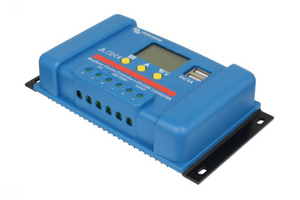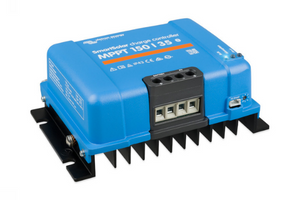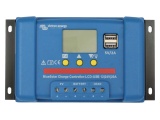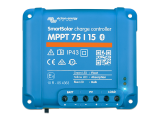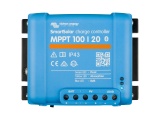PWM Vs MPPT Solar Controllers28 April 2022 | Paul Today we are taking a look at the two types of solar controllers currently available and examining the benefits each can bring to your system. Solar controllers take the energy harvested from your solar panels and regulate it to properly charge your battery, without over-charging. Whilst many brands exist, they all use either PWM or MPPT technology; but what does this mean, and how does it work? PWM ControllersPWM (Pulse Width Modulation) solar controllers act like a switch between your solar panels and battery. When your battery is attached to a PWM controller your solar panel's voltage is pulled down to be equal to that of that battery as a result of the large load and any voltage drop in the cable run. This voltage will only start to increase once the battery becomes more charged and its voltage increases. When the battery's absorption voltage is reached, the controller output starts switching on and off with a varying pulse length to prevent over-charge of the battery throughout the absorption stage. As a result of the voltage drop, you will never utilise your panel's full potential, even when the battery is fully charged and the voltage increases to 14.8V. To help you understand this, here are some quick examples using a typical 100W solar panel. This 100W panel can produce 4.95A, so when attached with a PWM controller to our battery and the the voltage is dragged down to 13V we get the following results:
Even with the battery fully charged and the voltage increasing to 14.8V, the power output is restricted:
As you can see, we are never utilising the panel's full potential (its maximum power point) because the voltage is being dragged down to 13V and we are therefore losing 35% of our panel's potential power output of 100W. Even at 14.8V, the loss is still around 25%. MPPT ControllersMPPT (Maximum Power Point Tracking) solar controllers are more advanced than PWM controllers. Using microprocessors & software, an MPPT controller will continually adjust the input voltage to harvest the maximum available power from the solar panel, which it can then convert to a usable output voltage for charging the battery. This type of controller prevents the battery and solar panel from becoming directly linked, thereby preventing the drop in voltage and the loss of maximum power seen with PWM controllers. Being able to handle the panel's maximum voltage is what allows the MPPT controller to provide a 30% (on average) increase in harvestable energy, especially in colder conditions. Temperature Temperature can have a significant impact on your panel's power output and this can also affect how your controller performs. Solar panels are designed to work best in cold conditions and therefore will produce their maximum power at lower temperatures. A solar panel will produce practically constant current no matter the temperature, however, the Maximum Power Voltage (the voltage at which the current output starts to tail off) will decrease as temperature increases. In warmer climates, therefore, the panel's ability to produce its full output power (voltage x current) decreases. This means that if you are in a warmer climate you may see a slight decreased performance from an MPPT controller as the Maximum Power Voltage gets closer to your battery voltage. If the unit has been sized correctly however this should not cause an issue as the panel voltage will always remain above the battery. If you only have 1 panel however you may find it provides the same performance as a PWM controller. Shading of Panels Shading of panels by overhanging trees or even just simple cloud coverage also drags solar panel voltage down even further, which means the power loss when using PWM controllers can be even greater. By using an MPPT controller, the voltage should remain much higher than that of the battery and thereby provide greater performance than PWM controllers. Using Panels in series will drag down every module that is connected in series with the shaded one. We therefore recommend parallel for applications where shading is likely, such as a yacht with shading from the mast or boom. Conclusion PWM controllers offer a low-cost solution for small solar arrays & would be best used in warm climates (40oC+). MPPT controllers not only attempt to harvest the full maximum power voltage, but allow you to add larger solar arrays that have higher voltages. They also offer the best performance in colder climates with cloudy/rainy conditions, or where shading of the panels might occur. We would recommend using a solar panel system with a higher voltage when compared to battery voltage, so 2x 12V modules in series for a 12V battery or at least 3x 12V modules for a 24V battery and so on. This will always optimise the harvest. Disclaimer The information contained in this article is provided in good faith and we do our best to ensure that it is accurate and up to date, however, we cannot be held responsible for any damage or loss arising from the use or mis-use of this information or from any errors or omissions. The installer is ultimately responsible for the safety of the system so if you are in any doubt, please consult a qualified electrician.
|
|
12 Volt PlanetAuto & Marine Electrical Components |
